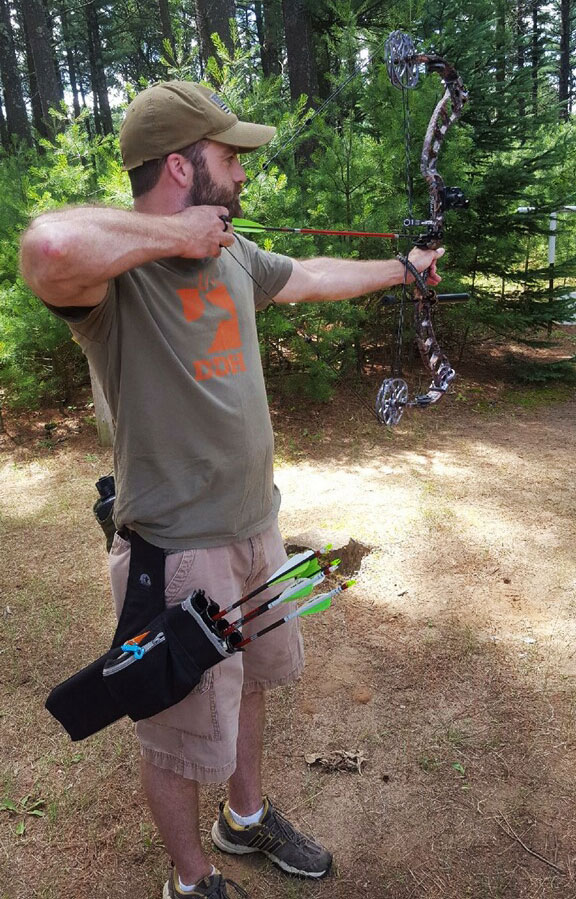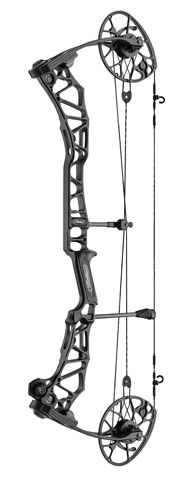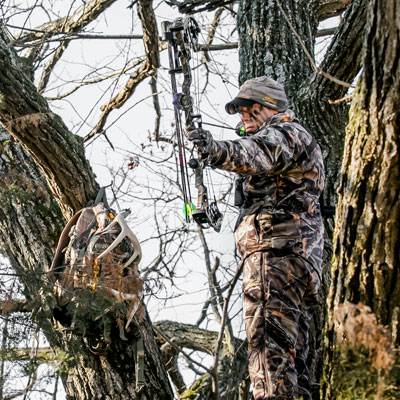Compound bows have gotten smaller every year in search of more speed and less weight. Here are several reasons why you might want to buck that trend, including top new picks from six companies.

I go through running shoes like a puppy goes through chew toys, and when I need new shoes, a trip from my tiny town to the big city is in order. On one of those trips, a good buddy, who had nothing better to do for the day, volunteered to ride along.
While trying on and testing some new kicks, I decided on a pair of Brooks. They felt great on the treadmill, and after taking them for a test drive in the parking lot, I was ready to make a purchase. The shoes were flat gray and featured a black Brooks emblem. They were by no means flashy or sexy, but their fit, feel and function were perfect.
My buddy had been trying to talk me into a pair of flashy, multi-colored Asics for the past hour. I tried them on, and though they didn’t feel bad, they sure didn’t feel great. I was headed for the cash register when my buddy stopped me. “Dude,” he said, “these shoes are awesome. Those Brooks are ugly. Plus, the Asics are a tad cheaper, and they look so cool.”
One week later I had a blister on my left toe the size of a nickel and my ankles hurt. Yep, I gave in to peer pressure. It was a stupid mistake.
Yes, I know this isn’t Runner’s World, but bear with me for a minute. Every year I’m lucky enough to perform in-depth field tests on the latest bows. I’ve received a number of emails from bow buyers who felt they made the wrong choice. Many admit they were talked out of their first choice by a spouse or friend.
Interestingly, many of these bow buyers had initially set out to purchase a new flagship model due to the fact that many 2019 bow makers came out with longer axle-to-axle models. But they didn’t end up taking a longer bow home with them. One buyer had a friend scoff, “We hunt whitetails from trees. That bow you want is 35 inches axle to axle. You’ll never be able to maneuver that log in a tree.” Another said his girlfriend kept telling him how much cooler he looked holding a short axle-to-axle bow, and that he would like it if he just took the time to get used to it. Yep, he caved. Ouch!
The Bottom Line
When you shop for a new bow, go alone. Archery is a game of inches, and it’s a very personal sport. When you find a bow that provides great fit, feel and function, as well as an ear-to-ear grin each time you trigger your release, that should be your bow.

Like many reading this, I’m a fan of long axle-to-axle bows. Do I hate shorter models? Nope! In fact, I have several that I shoot really well. But when it comes to a complete shooting system, I just personally love the rock-solid balance, the shot-to-shot accuracy and the general overall feeling I get when I trigger my release on a bow that stretches the tape. I’m not trying to convert those who prefer shorter bows. I have lots of friends who love their short axle-to-axle rigs, and their success rates speak for themselves. The bottom line is, if a longer axle-to-axle bow is right for you, don’t fight it. And if you’re in the market for a new bow and on the fence about length, test out a few and see what you think.
Worried about maneuverability in a treestand? I did a little research. After taking an Internet deep dive into five top-tier bow manufacturers in 2004, here’s what I discovered: The average axle-to-axle length of those 2004 flagship bows was 34¾ inches, average speed was 226 fps and average brace height was 7½ inches. Further research provided by the Illinois Department of Natural Resources showed that in 2004, Illinois archers, most of whom likely took to the hardwoods, harvested 63,639 deer. That’s 5,714 more stick-and-string kills than bowhunters made during the 2017-18 archery season.
That data alone should alleviate any concerns about longer bows and treestands. In addition, in my neck of southeast Colorado, I hang and hunt in the most crooked cottonwoods on God’s green earth, and not once has a longer axle-to-axle bow hindered my chances at a big buck.
Better Balance=Better Shooting
Prime Archery’s lead engineer, Nate Grace, knows a thing or two about bow design, and took the time to really clarify how better bow balance leads to better shooting.
“A lot of current bow designs are out-of-the-box unbalanced,” Nate said. “Starting with an unbalanced bow means the archer will have to become a stabilizer expert, and invest a lot of money in stabilizers to achieve perfect bow balance. Adding stabilizers and even sidebars adds weight to the bow, which makes holding on a big buck for 10-plus seconds, which is common in the whitetail woods, virtually impossible. At Prime, through Centergy technology, we design our bows to be out-of-the-box balanced. This creates a steadier hold, which leads to a fun shooting experience. When you can achieve precision accuracy, archery gets a lot more fun.”
Six Longer Bows to Consider
If you’re in the market for a longer in-the-field companion, head to your local pro shop and send some arrows downrange with any of these six new models.
Prime Logic CT5 (and CT9)
 Widely accepted as having the strongest risers in the compound bow arena, Prime stretched the 82X aluminum for 2019. Prime’s extensive testing has proven that Centergy technology provides the shooter with a 49 percent steadier on-target hold, and for 2019 its new CenterGrip has been moved up the platform to allow the shooter to get their bow hand deeper in the grip’s throat.
Widely accepted as having the strongest risers in the compound bow arena, Prime stretched the 82X aluminum for 2019. Prime’s extensive testing has proven that Centergy technology provides the shooter with a 49 percent steadier on-target hold, and for 2019 its new CenterGrip has been moved up the platform to allow the shooter to get their bow hand deeper in the grip’s throat.
In addition, Prime added what it’s dubbed “The Swerve,” which is a strategically designed curve in the riser engineered to synchronize any top- and bottom-half riser movement. Eliminating cam lean and adding to the Logic’s accuracy system is Prime’s legendary Parallel Cam System, which provides two string tracks rather than just one. Another notable accuracy enhancer for 2019 is the new Flexis-AR patented adjustable flexing roller guard, which allows the shooter to adjust the distance the cables are from the arrow to ensure maximum fletching clearance.
The Logic CT5 measures 35 inches between the axles, has a fighting weight of 4.6 pounds, boasts a brace height of 6 inches and can hit speeds up to 340 fps. The CT9 sports an axle-to-axle length of 39 inches, has a 7-inch brace height, features a mass weight of 4-3/4 pounds and can send projectiles downrange at 325 fps. Both offer swap-in, swap-out cable and limb stops so archers can achieve a custom back-wall feel, as well as the new Sherpa Quiver Mounting System. Both bows were built for accuracy, and when you shoot them, you’ll quickly take notice. MSRP: $1,099. Info: www.g5prime.com
Bear Revival
 Although I like to think Bear’s latest long axle-to-axle incarnation, the Revival, was named for an increasing demand for longer axle-to-axle bows, the truth of the matter is the name reflects the fact that the bow was built on the popular Bear LST platform. Designed to be a hunting bow first and a target bow second, the 37½-inch axle-to-axle Revival boasts a CrossLock Limb Pocket design that incorporates a multi-facet system to provide maximum strength at key stress points during and after an arrow is triggered. Adjustable RockStops promise a solid back wall, and SonicStops and SonicBonds soak up noise and vibration. The Revival offers a 7-inch brace height and weighs 4.4 pounds.
Although I like to think Bear’s latest long axle-to-axle incarnation, the Revival, was named for an increasing demand for longer axle-to-axle bows, the truth of the matter is the name reflects the fact that the bow was built on the popular Bear LST platform. Designed to be a hunting bow first and a target bow second, the 37½-inch axle-to-axle Revival boasts a CrossLock Limb Pocket design that incorporates a multi-facet system to provide maximum strength at key stress points during and after an arrow is triggered. Adjustable RockStops promise a solid back wall, and SonicStops and SonicBonds soak up noise and vibration. The Revival offers a 7-inch brace height and weighs 4.4 pounds.
As to why Bear decided to provide shooters with a longer axle-to-axle option, Bear Archery Marketing Director Jack Borcherding told me, “We had a lot of interest from our target archery crowd as well as our bowhunting crowd. They wanted a do-all bow. This rig is an offshoot of our popular LST, but we gave it a little facelift and made it more accessible to everyone. We reduced the overall weight and fitted it with better strings and cables.” MSRP: $699. Info: www.beararchery.com
PSE Carbon Air Stealth SE
In past years PSE has limited its carbon offerings to short axle-to-axle models, but for 2019, the manufacturer has taken its carbon to new lengths. Weighing just 3-1/2 pounds, the 35-inch axle-to-axle Stealth SE features a longer, stiffer and stronger monocoque carbon riser and is powered by the Small Evolve Cam (SEC) and HL module. This cam system is draw-length adjustable from 25 to 30½ inches, boosts overall bow performance, provides speeds up to 335 fps and has an adjustable let-off between 80 and 90 percent.
Whitetail hunters will love the warm-to-the-touch direct-to-riser grip and other innovations, such as the Wedge Lock Pockets, premium LiveWire strings and titanium hardware make this bow tough to ignore. The bow has a 6½-inch brace height and is a downrange tack driver. MSRP: $1,499. Info: www.pse-archery.com
Elite Ritual 35
Capable of speeds up to 336 fps and weighing 4.4 pounds, Elite’s Ritual 35 measures 34¾ inches between the axles. Offering a dual-caged riser, the Ritual 35 is fitted with the Ritual Cam, a system engineered to combine efficiency, smoothness, speed and accuracy in one package.
Having sent a few arrows downrange with the Ritual 35, I agree that this bow is both smooth and efficient, and it feels balanced and steady throughout the shot cycle. The bow boasts a direct-to-riser grip that is thin, perfectly angled and designed to reduce hand torque.
As with all Elite bows, shooters can custom build their Ritual 35 on Elite’s website. The Ritual 35 can be had in draw lengths between 26½ and 30 inches and draw weight options of 50, 60, 65 and 70 pounds. MSRP: $1,049. Info: www.elitearchery.com
Mathews Traverse
 Capable of fitting draw lengths up to 32-1/2 inches, this 2019 offering is a stunner. Available in a number of camo and custom color options, this 33-inch axle-to-axle killer was engineered to be balanced, quiet and spot-on accurate. Built on a highly stable dual-caged riser platform, this bow is unwavering at full draw, and the Crosscentric Cam System works in harmony with the bow’s split-limb design, riser and 3D Dampening technology to deliver a quiet, accurate and totally vibration-free shot.
Capable of fitting draw lengths up to 32-1/2 inches, this 2019 offering is a stunner. Available in a number of camo and custom color options, this 33-inch axle-to-axle killer was engineered to be balanced, quiet and spot-on accurate. Built on a highly stable dual-caged riser platform, this bow is unwavering at full draw, and the Crosscentric Cam System works in harmony with the bow’s split-limb design, riser and 3D Dampening technology to deliver a quiet, accurate and totally vibration-free shot.
The new Engage Grip is one you just have to feel and shoot to fully appreciate. The bottom line: It’s a win! The grip is warm to the touch, ergonomic and was designed to boost consistent hand placement and reduce torque. The grip is flat-backed, thin, perfectly angled and melts into the palm swell area.
The Traverse has a fighting weight of 4.7 pounds, hits speeds up to 338 fps and is branded with a 6-5/8-inch brace height. A downrange tack driver that will be favored by podium chasers as well as those looking to send an arrow through a pair of lungs, the Traverse is available in draw lengths of 26-1/2 to 32-1/2 inches and is offered in peak draw weights of 50, 60 and 70 pounds. MSRP: $1,099. Info: www.mathewsinc.com
Obsession FXL
Stability is key in any good relationship. Whether that’s between you and a whitetail, or you and your target, the new 2019 FXL provides all and compromises nothing.
This bow is designed with forgiveness and speed in mind, distance is no match regardless of the chase. Whether you’re high in a mountain range, high in a tree or toeing a line, this is the do-all bow for the archer who wants it all.
The FXL measures 34-1/2 inches (+ .125) axle to axle, features a 6-1/2-inch brace height and shoots 350 fps. Draw-weight modules start at 40 pounds and go all the way up to 80 pounds. Draw-length options start at 26 inches and go up to 31-1/2 inches. MSRP: $999. Info: www.obsessionbows.com
A Do-IT-All Bow
This past summer, on a long family road trip from Colorado to Minnesota, I stopped and visited five different archery pro shops. Each was located in a different state, and I talked with a lot of archers. In each shop, I singled out two archers and asked them the following three questions: 1.) Do you compete in 3-D and target archery? 2.) Do you bowhunt whitetails from treestands or ground blinds? 3.) Do you spot and stalk whitetails?
Guess what? All 10 archers answered “yes” to all three questions. Two of them did clarify that they only spot and stalk whitetails if they see them on their way to the treestand. I tell you this because a longer axle-to-axle bow is a do-all sort of rig. Competition shooters crave the balance and accuracy a longer bow delivers. And, sure, most whitetail bow shots from a treestand or ground blind are less than 40 yards, but I know that when the heart is pounding through the chest and the nerves are spiking, a longer bow keeps me steadier during the moment of truth.
When it comes to open-terrain spot-and-stalk sojourns, wind often plays a role, as does the distance the target animal is from your location. If competition shooters prefer a longer axle-to-axle bow when thousands of dollars are on the line, the wind is bucking and the target 12-ring is distant, you might want to follow suit.
There you have it — longer axle-to-axle bow myths debunked, some recommended models to test drive and some info on why you might want to make the switch. And if you’ve made your choice based on what someone else thought was best for you, head back to your local archery shop and get yourself the bow you want.




